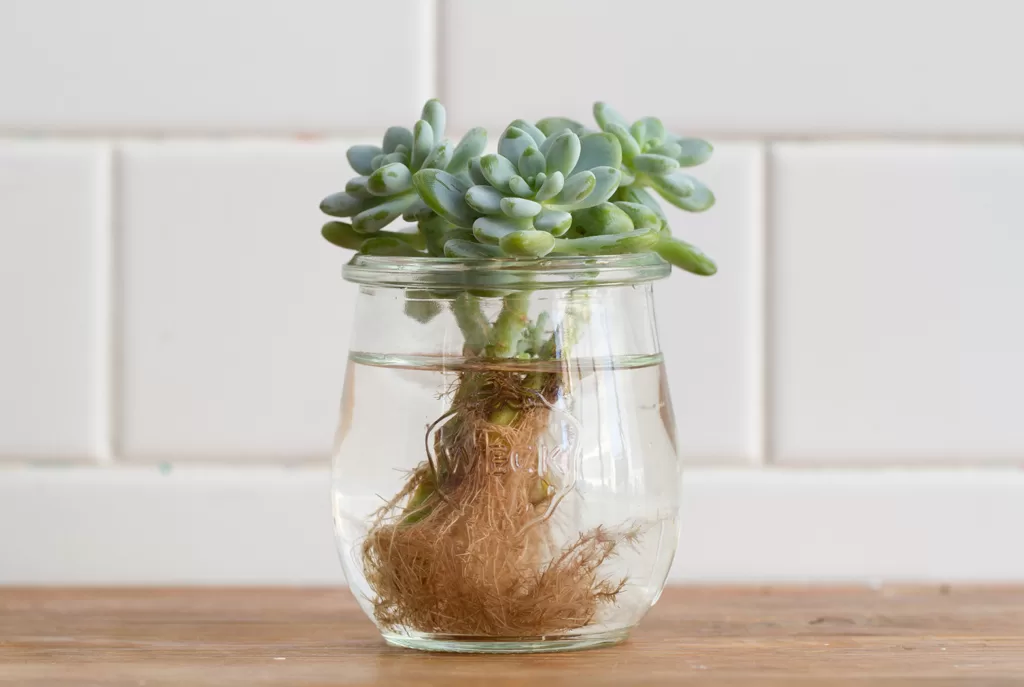To grow a jade plant indoors, you will need to provide the following:
- Bright, indirect sunlight: Jade plants prefer bright, indirect sunlight, so place your plant near a window that receives plenty of natural light.
- Well-draining soil: Use a well-draining cactus or succulent potting mix, or make your own by mixing equal parts of regular potting soil, sand, and perlite.
- Proper watering: Allow the soil to dry out slightly between waterings. Be careful not to over-water, as jade plants are susceptible to root rot.
- Temperature: Jade plants prefer temperatures between 60 and 75 degrees Fahrenheit (15-24 degree Celsius), and should be protected from drafts and cold temperatures.
- Humidity: Jade plants prefer low humidity, so be sure to place them in a location with good air circulation.
- Fertilizer: Feed your jade plant every 4-6 weeks during the growing season with a balanced, water-soluble fertilizer.
- Pruning: prune jade plant to maintain its shape and size.
By providing the proper care, your jade plant should thrive indoors for many years.
Table of Contents
Do jade plants need special soil?
Jade plants (Crassula ovata) are relatively easy to care for and do not require special soil. They prefer well-draining, sandy or rocky soil, similar to the soil they would naturally occur in. It is important to make sure the soil is not too dense and does not retain water, as jade plants are susceptible to root rot. A cactus or succulent potting mix would be a good choice for jade plants.
Can you bury the stem of a jade plant?
Yes, you can bury the stem of a jade plant. This is a method of propagating jade plants, also known as “stacking.” To do this, you will need to take a stem cutting from an existing jade plant. Allow the cutting to callus over for a few days. Once the cutting has callused, bury the stem about an inch or two deep in a well-draining soil mixture such as a cactus or succulent potting mix. Keep the soil moist but not waterlogged, and in a few weeks, roots will form and new growth will appear. Once you see new growth, you can care for it as you would a mature jade plant.
Does a jade plant turn into a tree?
Jade plants (Crassula ovata) are a type of succulent, and are commonly referred to as “money tree” or “dollar tree” because of their thick, fleshy leaves. They can be grown as a small shrub or as a small, bonsai-like tree. With proper care, a jade plant can grow to be quite large, with a thick trunk and multiple branches. However, it is not considered a “tree” in the traditional sense, as it does not have a single main trunk that branches into smaller limbs.
Instead, a jade plant can be trained and pruned to grow in a tree-like shape over time, giving it a bonsai-like appearance. It will still be considered a succulent or a small shrub and not a tree.

Which jade plant is lucky?
Jade plants (Crassula ovata) are considered to be lucky plants in many cultures, particularly in Chinese and Asian cultures. They are often referred to as “money tree” or “dollar tree” because of their thick, fleshy leaves, which are said to symbolize prosperity and good fortune.
In feng shui, jade plants are believed to bring positive energy, wealth and prosperity to a home or office. They are often placed in the southeast corner of a room or building, which is said to be the area associated with wealth and prosperity.
It is commonly believed that the more leaves a jade plant has, the more luck it will bring. So, in this context, a jade plant with more leaves is considered to be more lucky.
Is Jade a Vastu plant?
Jade plants (Crassula ovata) are considered to be auspicious in Vastu Shastra, an ancient Indian system of architecture and design that aims to create harmonious and balanced environments. In Vastu, plants are believed to bring positive energy and prosperity to a home or office. Jade plants are particularly beneficial because of their thick, fleshy leaves, which are said to symbolize wealth and good fortune. They are often placed in the southeast corner of a room or building, which is said to be the area associated with wealth and prosperity. It’s also believed that jade plants can purify the air and balance the elements in a room, making it a great plant for both indoor and outdoor spaces.
It’s also worth noting that Vastu principles are based on ancient Indian beliefs and may not be scientifically proven, so it is important to keep personal beliefs and preferences in mind when decorating your space.

What is the luckiest plant?
Different cultures and traditions have different beliefs about which plants are considered lucky. In general, plants that are believed to bring prosperity, good fortune, and positive energy are often considered to be lucky plants. Some examples of plants that are considered to be lucky include:
- Jade plants (Crassula ovata) in Chinese and Asian cultures, it is considered to be a symbol of prosperity and good fortune.
- Money trees (Pachira aquatica) in Chinese culture, it is considered to bring wealth and good luck.
- Bamboo in Chinese culture, it is considered to bring good luck and prosperity.
- Orchids in many cultures, it is considered to be a symbol of wealth and good fortune.
- Peonies in Chinese culture, it is considered to bring good luck and prosperity.
- Citrus trees such as lemon and orange, they are considered to bring good luck and wealth.
- Lucky bamboo (Dracaena sanderiana) is believed to bring good luck and prosperity.
- The Fern is considered to bring good luck and prosperity.
It’s also worth noting that most of the plants are considered lucky for many reasons such as for its beauty, its ability to purify the air, and it’s believed that certain plants can balance the elements of a space. It is important to keep personal beliefs and preferences in mind when choosing plants for your home or office.
Are jade plants poisonous?
Jade plants (Crassula ovata) are not considered to be toxic to humans or animals. However, like any plant, it is possible to experience an allergic reaction upon contact with the leaves or sap. If ingested, jade plants may cause minor stomach upset, but are not considered to be poisonous.
It’s also worth noting that, while jade plants are not toxic, they can be mildly irritating to the skin and eyes, so it’s best to handle them with gloves and avoid getting the sap in your eyes.
It is always important to keep an eye on children and pets around any plants and make sure they do not ingest any of the plant.
If you have any concerns or notice any adverse reactions, seek medical attention.
What season does Jade grow?
Jade plants (Crassula ovata) are a type of succulent and they grow best in warm temperatures and bright, indirect light. They are tolerant of a wide range of temperatures, but prefer temperatures between 60-85°F (15-30°C). They are drought-tolerant plants and can survive long periods without water, but they do best with regular watering during their active growth period.
Jade plants typically have an active growth period in the spring and summer months, where they will produce new leaves and branches. During the fall and winter, they will enter a dormant period where growth slows or stops. During this time, it’s important to reduce watering and allow the soil to dry out completely before watering again, as jade plants are susceptible to root rot if overwatered.
It’s also worth noting that jade plants are slow-growing plants and can take a long time to reach maturity. They can live for many years with proper care and can become large and impressive specimens.






